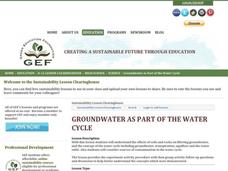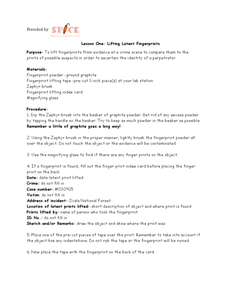Curated OER
Research Projects in Renewable Energy for High School Students
Thirty-eight pages of information prepares you to assign middle or high schoolers a project on sustainable energy. They take a pretest, review the scientific method, conduct background research, and finally choose an experiment to carry...
Curated OER
Atomic Candy
Mmmmm! Radioactive "candium!" Nuclear physics or chemistry classes use M&M'S® to demonstrate the process of radioactive decay. Individuals pour out a bag of candies and record the number that fall M-side-up to represent the...
Curated OER
Float a Hot Air Balloon
This activity will lift spirits in your class, but there is little scientific explanation for what makes a hot air balloon rise. As you are teaching middle school scientists about density and convection, you can incorporate this...
Curated OER
Reading the River
In collaborative groups, young ecologists measure the temperature, pH, and dissolved oxygen for three different freshwater samples. They examine each sample with a microscope and record observations on the microorganisms in the pond...
Curated OER
Fluorescence
Here are some instructions for leading learners through a hands-on activity for investigating ultraviolet radiation. First, introduce them to light and refraction. Then introduce them to the electromagnetic spectrum. Finally, give...
Curated OER
Titration Results Sheet
There are two identical half-sheets on this page, each including a data table to indicate the outcome of a titration experiment. Chemistry technicians fill in the reagents used, the final and initial volumes of the titration, and the...
Curated OER
The Purpose of Each Part of a Plant
Beginning botanists can sketch the parts of a plant in individual boxes, or better yet, they can tape or glue actual plant parts in them. Beside each box are a few sentences with selected words left out. From the word bank at the bottom...
Curated OER
Bacteria Lab I: Preparing Agar Plates and Culturing Bacteria
Bacteriologists prepare their own agar plates and culture bacteria on them. The procedures for both tasks are delineated, and questions are posed, but no materials list is printed. Also, the exact amounts of water and nutrient agar are...
Curated OER
Ice Cream
Open this instructional activity by giving a brief history of ice cream. Using liquid nitrogen to lower the temperature, preteens make their own confection. The accompanying activity sheet queries learners about freezing point, the...
Curated OER
Dry Ice Activities Mini Lesson
Get your middle schoolers experimenting with dry ice. In the first activity, they place a piece in water and then use phenol red to identify its pH. In the second, they place a piece in a limewater solution and watch as the combination...
Curated OER
Experiment to Mimic the Digestive System
Biology lab technicians take a cheese sandwich apart as a demonstration of digestion. They record appearance and mass both before and after the process, which mimics chewing, acid action, and churning. Learners write their own lab...
Curated OER
Groundwater as Part of the Water Cycle
Make sure to read through the activity procedures thoroughly before teaching this lesson because the materials list is incomplete. Also, the mentioned worksheets and booklet are not available. However, there is no need to discard this...
Curated OER
Strawberry Smoothies
Biologists extract the DNA from a strawberry. After completing the procedure, learners write answers to a few questions on the lab sheet provided. This is ideal lab practice during a DNA unit in your general biology course.
Curated OER
Soil Porosity, Moisture Content, pH, and Density
This lab activity does not have to be done with AP environmental scientists. It can also be done with middle to high school earth scientists. The procedures aren't complex. Learners determine the density of dry and wet sand in order to...
Curated OER
Blast Off
In this physical science exploration, small groups place a piece of antacid tablet into a film canister and step back to time how long it takes for the top to pop. They repeat the activity, altering either the amount or temperature of...
Curated OER
What Parts of a Plant Do We Eat?
Did you know that tomtoes and cucumbers are actually fruits? Biology or botany beginners read about the function of flowers and fruit and find that some food items commonly called vegetables are, by definition, also fruits! Give learners...
Curated OER
Moldy Jell-O
Mini mycologists plan an experiment to determine what affects the growth of mold on gelatin. A list of available materials is provided, but the procedure needs to be designed by the lab group. A data table is also provided in...
Curated OER
Comparing Mitosis with Meiosis
Life science learners view an online animated mini textbook comparing two types of cell division. Working in groups, they use a digital microscope to capture images of cells in different stages of mitosis and meiosis. Then they create an...
Curated OER
Allocating Energy from a Photovoltaic System
How much electricity do you use in a day? Physics fanatics calculate their energy use by consulting a chart of the watts required to run typical household appliances. They compare power to amounts of electric energy used or generated....
Curated OER
Lesson One: Lifting Latent Fingerprints
Crime scene investigators practice collecting fingerprints off of surfaces in order to compare them to an imaginary crime suspect's prints. Instructions for using graphite powder and a Zephyr brush to collect the evidence are outlined....
Curated OER
Lipstick Chromatography/Ink Chromatography
Junior crime scene investigators are instructed in two different chromatography exercises. For female suspects, they separate and compare lipstick pigments. For male suspects, they separate and compare ink samples. A data sheet is...
Curated OER
Oxidation of Iron - An Example of a Combination Reaction
Here are photos and general instructions for demonstrating two oxidation reactions with your physical science beginners. They use salt and hydrogen peroxide to cause iron filings to rust, and they combine hydrogen peroxide with a piece...
Curated OER
Rock Cycle Activity
A few of the components of this lesson are not possible to carry out because the rock cycle diagram and challenge handouts are not included. Hopefully, you already have your own rock cycle diagram or worksheet to use as a concept...
Curated OER
WET Science Lesson #3: Comparison of Aquatic and Terrestrial Plants
Elementary life science explorers compare and contrast aquatic and terrestrial plants (elodea and soybeans) in a Venn diagram. Some background information is provided to support direct instruction, and general instructions are provided...

























